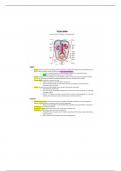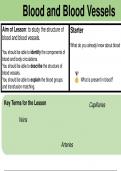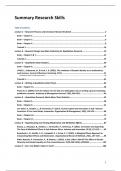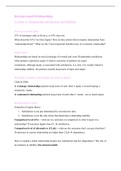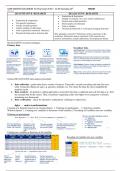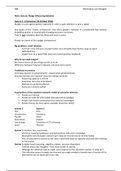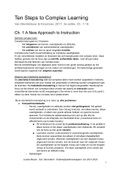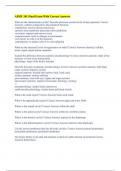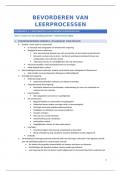Oscillations
Oscillation: the cyclical and periodic variation of the displacement x of an object about an
equilibrium position (x=0).
- "Cyclical”: the motion repeats in cycles,
- "Periodic": the motion occurs at regular intervals
- Displacement (x): distance of a point on the wave from its equilibrium position. As a
vector quantity, it can be positive/negative [m - meters].
- Amplitude (A or 𝑥0): the maximum displacement of an oscillating wave on either
side of the equilibrium position. Depends on initial energy input from primary
oscillator.0
- Wavelength (λ): length of one complete complete oscillation measured from the same
point on two consecutive waves [m - meters].
- > frequency < wavelength
- Period (T): time interval for a point on the wave to undergo a complete repetition [s -
seconds]. Depends on the medium’s properties (e.g mass and spring constant, or length
of a string etc.) not on the energy supplied by primary oscillator or displacement.
- Isochronous: oscillations have a constant period.
- Frequency (f): number of full oscillations per second [Hz - hertz, or s-1]
1
𝑓= 𝑇
,
,Simple Harmonic Motion (SHM)
SHM: a motion arising from a linear restoring force directed to a fixed equilibrium position.
Conditions of SHM:
- Fixed cyclical path
- Isochronous (i.e the motion repeats at equal time intervals)
- Central equilibrium point
- Displacement, velocity and acceleration change continuously
- Linear restoring force directed to equilibrium position and opp. to displacement
Linear Restoring force
- Switch direction every half cycle, becoming 𝐹𝑛𝑒𝑡 = 0 at equilibrium point,
- |𝐹𝑛𝑒𝑡 | not constant, but increases proportionally with displacement.
𝐹𝑛𝑒𝑡 ∝ (− 𝑥)
𝑎 ∝ (− 𝑥)
- Hooke’s Law (spring system): 𝐹𝑛𝑒𝑡 = − 𝑘𝑥, where k is spring’s constant
- > k → > acceleration > frequency, < period, = amplitude
, SHM in pendulum
- 𝑇 − 𝑚𝑔𝑐𝑜𝑠θ = 0, no motion along string
- 𝑚𝑔𝑠𝑖𝑛θ = 𝑚𝑎, tangential motion → 𝑎 = 𝑔𝑠𝑖𝑛θ
SHM in spring
0 1 2 3
Displacement (x) < > < >
- - + +
Acceleration (a) < > < >
+ - + -
Speed (v) >, at < rate <, at > rate >, at < rate <, at > rate
- - + +
Oscillation: the cyclical and periodic variation of the displacement x of an object about an
equilibrium position (x=0).
- "Cyclical”: the motion repeats in cycles,
- "Periodic": the motion occurs at regular intervals
- Displacement (x): distance of a point on the wave from its equilibrium position. As a
vector quantity, it can be positive/negative [m - meters].
- Amplitude (A or 𝑥0): the maximum displacement of an oscillating wave on either
side of the equilibrium position. Depends on initial energy input from primary
oscillator.0
- Wavelength (λ): length of one complete complete oscillation measured from the same
point on two consecutive waves [m - meters].
- > frequency < wavelength
- Period (T): time interval for a point on the wave to undergo a complete repetition [s -
seconds]. Depends on the medium’s properties (e.g mass and spring constant, or length
of a string etc.) not on the energy supplied by primary oscillator or displacement.
- Isochronous: oscillations have a constant period.
- Frequency (f): number of full oscillations per second [Hz - hertz, or s-1]
1
𝑓= 𝑇
,
,Simple Harmonic Motion (SHM)
SHM: a motion arising from a linear restoring force directed to a fixed equilibrium position.
Conditions of SHM:
- Fixed cyclical path
- Isochronous (i.e the motion repeats at equal time intervals)
- Central equilibrium point
- Displacement, velocity and acceleration change continuously
- Linear restoring force directed to equilibrium position and opp. to displacement
Linear Restoring force
- Switch direction every half cycle, becoming 𝐹𝑛𝑒𝑡 = 0 at equilibrium point,
- |𝐹𝑛𝑒𝑡 | not constant, but increases proportionally with displacement.
𝐹𝑛𝑒𝑡 ∝ (− 𝑥)
𝑎 ∝ (− 𝑥)
- Hooke’s Law (spring system): 𝐹𝑛𝑒𝑡 = − 𝑘𝑥, where k is spring’s constant
- > k → > acceleration > frequency, < period, = amplitude
, SHM in pendulum
- 𝑇 − 𝑚𝑔𝑐𝑜𝑠θ = 0, no motion along string
- 𝑚𝑔𝑠𝑖𝑛θ = 𝑚𝑎, tangential motion → 𝑎 = 𝑔𝑠𝑖𝑛θ
SHM in spring
0 1 2 3
Displacement (x) < > < >
- - + +
Acceleration (a) < > < >
+ - + -
Speed (v) >, at < rate <, at > rate >, at < rate <, at > rate
- - + +

